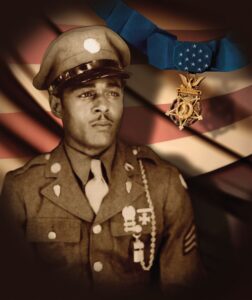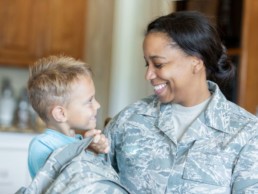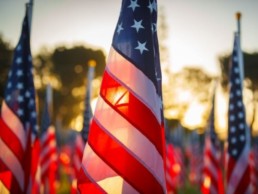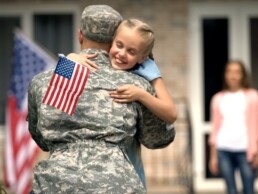Many Veteran Women may be long overdue a Purple Heart Medal!
Women have only been active in the military for 70 years, but in each of those years they have joined in a significant amount, increasing every year. Compared to 1973, where enlistment of women soldiers was approximately 70,000, there are more than 200,000 women in active duty today serving in every branch of the U.S. military. Given the number of servicewomen, including having courage for being on the front lines and getting hurt, why do so few women actually receive their Purple Heart Medal? As you know, The Purple Heart is the only medal awarded to service members when they have greatly sacrificed themselves and have been injured in the line of duty. It has been known throughout history that men are usually the ones out fighting since the earliest wars. It is possible that the sheer number of men compared to women in the military today can still overshadow the many contributions that women have made. But that is unfair. With this in mind, we want to call attention to and highlight the disparities, share their stories, and acknowledge the contributions of our women vets. Based on the sheer quantity of women service members and no short supply of accomplishments and sacrifice, there should be more that have received the medal. All veterans deserve to be recognized for their sacrifices, especially from the physical, mental, and emotional scars that they will carry for the rest of their lives.
Women and the Purple Heart Medal
Women began to join the military in 1948, just three years after the end of World War II. President Harry S. Truman signed the Women’s Armed Services Integration Act into law, officially allowing women to serve as permanent members of all branches of the Armed Forces. Surprisingly, there have only been approximately 500 women that have been awarded the Purple Heart medal in the entire history of the military. There is no doubt that there are more women who are eligible for the award, but either they have not applied or have not been recognized. It is extremely important to recognize the sacrifice of their bodies and minds on the battlefield because each woman in active duty has given up some important qualities of their lives for our country, including time away from their families, losing physical abilities they once had, and losing their sanity . The medal is an example of the honor that the United States bestows upon them and all of our veterans deserve this respect.
Antoinette Scott’s Story
She was actually the first woman from Washington D.C. to have received the Purple Heart. She served eight years in the D.C Army National Guard and was deployed to Iraq in support of Operation Iraqi Freedom in 2003. She recalls the time her injuries happened during her mission driving a truck with soldiers to Baghdad Airport while being under attack. She managed to get the entire group to safety. She says, “There was so much going on, I didn’t have a chance to think about myself until I touched my face and I thought it was sweat and I saw blood. At that moment, I’m like, ‘Someone is bleeding,’ it wasn’t happening to me in my mind.” The truck was hit by an explosive device that led to shrapnel going through the left side of her face, breaking her jaw and a main blood vessel to her brain. She sustained life-threatening injuries, but the team she drove was able to evacuate her on time to save her life.
Marlene Rodriguez Story
She served three tours in Iraq before she had to retire and come back home. Marlene retired in 2009 due to experiencing two roadside bomb explosions and a firefight during her time in Iraq. She was diagnosed with traumatic brain injury (TBI) and Post-Traumatic Stress Disorder (PTSD), which left her disabled. She says, “I miss it so much. Just the structure, the discipline, the leadership,The honor.” As a result of her time in war, Marlene suffers from seizures, is unable to walk far due to back problems, and cannot express herself how she wants. Today, Marlene is frustrated with all the problems that will plague her for the rest of her life.
Conclusion
Antoinette and Marlene’s stories are just two stories of many in combat that still suffer from physical and mental injuries sustained in the battlefield. We salute and honor these two heroes, as well as countless others affected. What we are witnessing with these women is history in the making. Even today women can still become some of the first of 1,000 women to ever receive the medal, compared to more than 1 million men who have received it. These women throughout history have been soldiers, leaders and have sacrificed for the essential freedoms that we enjoy today. But unfortunately, most of them won’t receive a ticker tape parade, let alone the Purple Heart Medal. We want to encourage those who have not received the medal to apply if eligible. If you believe you know someone that does not have the medal and could be a candidate, recommend them to apply as it’s never too late to do so. Here is a website that shows the documents, resources, and examples of what needed to apply for the Purple Heart Medal.
Can We Talk About How Veteran Service Dogs Work Hard To Be More Than Just Man’s Best Friend?
Ever notice when you’re out at the gym, or the grocery store, or the train station,places you least expect to see an animal, you see a person walking with a dog? Well, your eyes aren’t deceiving you and these are not just any ordinary canines, they are actually incredibly trained service dogs. You likely won’t see the effects of what they do or how they help out their owner, but there is more to them than meets the eye. Service dogs assist veterans with different needs in a variety of ways and it is something that, as a veteran supporting community, we should talk about. They aren’t just there to keep company, but to help handlers with disabilities so that they can lead more independent lives.
The Best of the Best
Service dogs can help in the range of physical, sensory, psychiatric, intellectual, or even mental disabilities that a veteran can have. About 50% – 70% of dogs picked fail through service training. Dogs must be above average when it comes to their abilities, and this is only the very beginning of determining a worthy service dog. Service dogs in training must be able to exhibit a desire to work, a calm demeanor, high intelligence, and have a friendly and loving disposition. So, it takes more than a good nose to be a service dog.
Testimony
Veteran Toye Hickman is a service dog owner who shared her testimony about how her life has changed since she first got her service dog, as she deals with post-traumatic stress disorder, depression and anxiety. “He understands when my anxiety is going up. He’ll follow me around, he’ll pester me to get up and do something,” Hickman said. “If I’m having a down day, even though he’s a very active dog, he’ll lay right beside me and won’t leave my side.” Toye says her life changed when her service dog Bake entered it just two years ago.
Purple Heart Testimony / Clay the Service Dog
The Purple Heart Foundation believes that service dogs can truly help veterans, and that is why we offer this program to veterans. Watch retired veteran Jim Mirick, in his own words, detailing how much his service dog has helped him. He states, “He and I have such a bond together, he’s very tight with me, he’s irreplaceable to me.” Speaking of service dogs, our newest member to the Purple Heart Foundation family is Clay the service puppy, named after Purple Heart Recipient and former Purple Heart Foundation board member, Clayton Jones who passed in 2021. Clay is in the early stages of his nearly twenty four month training program, and from what we can tell he is determined and working hard through the process as a young student.
Conclusion
When the time comes, Clay will be matched with an honorably discharged veteran and their family, hopefully providing invaluable support while making a significant difference in a veterans’ life. Giving new meaning to the phrase Man’s best friend, our returning heroes, with their new companions, will be able to return towards the path of independence. Click here to learn more about our service dog program.
Could Golf Help Survivors Suffering from PTSD?
Did you know that when a service member goes through a traumatizing event, likely caused in battle, it can leave behind harrowing mental and emotional scars? What we now know as Post Traumatic Stress Disorder forms as a result and creates problems for our veterans, the most common symptoms are anxiety and depression. Because PTSD is an unseen condition where the symptoms can get worse and affect everyday life, many of our nation’s veterans must find a way to cope and deal with the stress of trauma related PTSD, by finding support. Surprisingly, one good way that helps veterans is through recreational therapy. More specifically, golf.
It’s been proven that a consistent physical regiment can help decrease the impact of PTSD over time. According to one study, “A 12-week exercise program that included three 30-minute resistance training sessions a week, as well as walking, was found to lead to a significant decrease in PTSD symptoms, depression, and better sleep quality after the program ended.”
It was very helpful to learn that veterans can treat PTSD by playing golf because it helps take their mind off things, it brings physical exercise from playing, and they can meet new peers while sharing 18 holes. Remember, golf is a lengthy game and full of competitiveness, making it easy to get distracted from your problems, thus acting like a therapy for PTSD.
For the past six years, many veterans have participated in a joint program with the Purple Heart Service Foundation and the local VA Hospital to participate in the 6th Annual Purple Heart Open as a part of their therapy. Vets take the opportunity to not only relieve stress, but also to talk with other veterans who can relate to their experiences . Matthew Levine, a retired U.S. Army Veteran, says “Golf has been a way to reduce stress and get back to normal.” Another veteran, Ed Afanador, says “It gives you a common ground if you’ve been injured, and you have someone to talk to that has that commonality between each other.”
As the weather is heating up, we hope more veterans will take the opportunity to get outside and get active. The Purple Heart Open may only come once a year, but the golf course will be open all summer long.
Mesothelioma in Veterans: 4 Things to Know
Veterans today are at risk for developing a multitude of illnesses that can range in impact from mild to extreme. Whether it be a physical injury from one incident, or delayed onset symptoms as a result of prolonged exposure to certain hazards, the life of a veteran can be in danger long after they are no longer actively serving. One serious illness that veterans can be at risk of developing is mesothelioma. Here are some things that all veterans should know about this dangerous cancer:
1. Veterans make up 30% of those diagnosed with mesothelioma in the United States.
Mesothelioma is a rare form of cancer caused by the inhalation or ingestion of asbestos fibers. Asbestos is a mineral that can be found in various construction materials, especially in products used prior to the 1970s. Due to its average 10-50 year latency period, mesothelioma does not usually present itself until much later that the asbestos exposure occurs.
While all veterans and active duty service members are at risk for having been exposed to asbestos, you are more likely to have been exposed and develop mesothelioma if you served between the years 1930 and 1980. This is due to the high volume of asbestos products being used and the low restrictions of their use.
There is an even higher correlation between mesothelioma and navy veterans. Asbestos-containing materials are especially common in shipyards and shipbuilding materials, and being in tight spaces can increase the risk of asbestos fiber inhalation. Veterans who served in this branch should be high-alert for mesothelioma symptoms.
2. Mesothelioma can affect more than the lungs.
Mesothelioma is often thought of as only being a type of lung cancer. However, this disease has various types that can impact different parts of the body. Each type of this cancer also comes with a different set of symptoms. The most common form of mesothelioma is pleural mesothelioma, which affects the lining surrounding the lungs. This type of mesothelioma is responsible for about 80-90% of diagnosed cases. Symptoms of pleural mesothelioma might include chest pain, a persistent cough, coughing up blood, shortness of breath, fever, and night sweats.
The next most common form of this cancer is peritoneal, which affects the lining that surrounds your abdominal organs. Peritoneal mesothelioma can include symptoms like abdominal pain and swelling, weight loss, and even blood clotting.
The two other, more rare, types of mesothelioma are pericardial and testicular. Pericardial mesothelioma affects the lining surrounding the heart, and testicular mesothelioma affects the lining around the testicles. Symptoms of mesothelioma in your heart include chest pain and an irregular heartbeat. And for testicular mesothelioma,you might experience testicular pain, scrotal swelling, and you might even notice a mass.
3. Asbestos exposure is possible even after active duty.
While exposure to asbestos might be more likely to occur during active duty, veterans can also be at risk for exposure depending on their career path after serving. Because of skill sets gained from your time in the military, many veterans may choose to follow careers in engineering, construction, or mechanics. These occupations are all at risk for asbestos exposure due to the products used.
You may also be at risk after your years of active service from secondhand asbestos exposure. Secondhand exposure can occur when there are asbestos fibers left on your uniforms or personal belongings, and you end up inhaling or ingesting them. You could also come into contact with someone who is still serving and in the presence of asbestos-containing materials, which could put you at risk.
4. You have resources to help.
If you have suspected symptoms of mesothelioma, it is crucial to visit a doctor. Early diagnosis can be critical in the setup and success of mesothelioma treatment. However, both the treatment for mesothelioma and the illness itself can greatly impact your financial situation and your ability to provide for yourself and your family. Luckily, organizations have recognized this and have implemented ways to help.
The U.S. Department of Veteran Affairs (VA) recognizes illnesses due to asbestos exposure during service and has made financial benefits available for things like expensive treatments and potentially lost wages. Veterans can file a mesothelioma VA claim, or an asbestos-related lung cancer claim, both of which are given a 100% disability rating. The VA can also assist with finding specialized care through VA accredited hospitals.
Life after active duty can be a difficult period of adjustment and you may still feel the impacts of your time in the service for years to come. You can set yourself up for life-long success by arming yourself with as much information as possible and the knowledge that you have help available to you.
4 Ways to Give Back
There are a few days throughout the year when we think about or officially recognize veterans and service men and women. But there are ways to give back to current and former members of our military every day of the year.
Say thank you.
When you see a service man or woman in uniform, or a person wearing something that identifies them as a veteran, take a minute to say hello and thank you. You don’t need to make a big, dramatic gesture; just let them know you appreciate their service. If they feel like talking, take the time to listen to their stories.
Hire a vet.
Do you own a business? Consider hiring a veteran. You can work with the United States Department of Labor’s VETS Program, or similar nonprofit organization that helps vouch for and place qualified veterans in businesses.
Stay informed.
Only a fraction of U.S. citizens currently serve, and few Americans have personal contact with members of our military, causing a disconnect between the military and the civilian worlds. Take some time to get informed about the issues facing our troops and veterans. Follow veteran organizations on social media, and learn about how you can help.
Make a donation.
When you donate to the Purple Heart Foundation, your generous gift helps us to support veterans and their families during their transition from the battlefield to the home front.
Our programs and those to which we award grants support hundreds of thousands of our nation’s heroes. There are many ways you can make a tax-deductible donation.
- Visit our website and make a credit card donation.
- Call us at 888-414-4483 or complete the form to donate your vehicle.
- Schedule a pick-up to donate clothing or household goods.
- Simply text PURPLE to 20222 to make a $10.00 donation right now.
- Consider becoming a Purple Heart Legacy member, and leave a gift from your estate. Call us at 703-256-6139 to discuss your options.
We often get asked how we use your donations. Here is a snapshot. If you want more information, give us a call; we would be happy to share it with you.
We use your generous donations
- To help fund research and assistance that tackle the unseen wounds impacting veterans, things like Post Traumatic Stress (PTS), Traumatic Brain Injury (TBI); suicide, and sexual abuse
- To fund Purple Heart’s Service Officers, who are stationed throughout the country to work with veterans informing them about education opportunities, scholarships, disability compensation, employment training, hospitalization and rehabilitation benefits, pensions, and more
- To employ a full-time attorney dedicated to protecting the interests of wounded servicemen and women and presenting veterans’ claims before a court
Traumatic Brain Injury and the Importance of Connection
Often referred to as the signature injury of the Iraq and Afghanistan wars, the prevalence of traumatic brain injury (TBI) among veterans is higher than it’s ever been. The most common cause of TBI among Operation Enduring Freedom and Operation Iraqi Freedom service members is injuries suffered from Improvised Explosive Devices, or IEDs, used extensively against Coalition Forces.
Many people who sustain a Traumatic Brain Injury recover completely. However, in severe cases, a traumatic brain injury can cause emotional and behavioral changes that can be difficult to understand and accept.
A traumatic brain injury affects the entire family and often results in financial challenges, job loss and isolation. In the United States, 1.7 million people sustain a TBI each year. Whether you have suffered a TBI or are caring for someone who did, understanding you’re not alone is critical, the best thing you can do is reach out.
Join a group
Meeting in person with other people with similar experiences can be cathartic. There are several places to find groups in your area.
Meetup.com has many brain injury and veteran meet ups across the country.
The Brain Injury Association of America has local chapters and various support groups throughout the U.S.
Share your story
When you can share your story and hear the stories of others, you realize there are people out there who understand what you’re going through, who can commiserate, or help put things in perspective. Luckily, the internet makes sharing easier than ever.
Brainline Military is an organization that serves the military community providing information, resources, and support for current and former service members and their families living with traumatic brain injury. Read the personal stories of military members living with TBI, and share your own.
A quick search for “Facebook TBI support group” turns up a handful of pages where you can connect on Facebook and be part of the conversation.
Get Informed
Knowing about traumatic brain injury—the symptoms, treatment options, and benefits you’re eligible for as a veteran or active duty military—will allow you to thrive, not just survive with this condition.
Take a look at our list of TBI resources.
20 is 20 Too Many #BeThere
September 1 marked the start of Suicide Prevention Month. Throughout the month, individuals and organizations have been raising awareness about different suicide prevention programs. Programs such as the Yellow Ribbon Suicide Prevention program, 22Kill, and Operation Never Forgotten all give support to those who are battling suicidal thoughts or actions and give them an outlet to share their frustrations. The Purple Heart Foundation also has a suicide prevention program to help those who may be contemplating suicide.
The topic of suicide can be a difficult topic to bring up, especially if you or someone you love is showing signs of possibly attempting to end their life. The most important thing to remember when having this conversation, according to Dr. Andrew Tomacari, is to show genuine support for the person during this tough period in their lives. Having a heartfelt conversation can help the person open up and start a conversation about how they’re feeling.
In 2014, the Department of Veterans Affairs reported an average of 20 veterans die from suicide each day, and six of the 20 used VA services. There is continued evidence, according to a July 2016 report that middle-aged and older veterans have a high burden of suicide. For families of veterans who have committed suicide, sharing their story can help other veterans who are thinking of ending their life. When Army veteran Daniel Somers committed suicide on June 10, 2013, he asked his wife to share the note he wrote to his family as she saw fit in order to raise awareness.
Holden Corzine, an Army Veteran of the War in Afghanistan ended his life on April 6, 2016. The 29-year-old suffered from PTSD after he came back from Afghanistan and sought out treatment. Even with the help he received, Holden struggled. Holden’s parents share his story in an effort to raise awareness, “My wife and I both thought if it helped one person, it was worth it. All we wanted people to do is get help, hang onto their loved ones, and let them know things would be OK,” Holden’s father Jhan said. “Sometimes that’s not enough.”
One of the reasons for the rate of suicide in the military is the stigma that military personnel need to be strong and not ask for help.“In the past, it was an unwritten rule (in the military) that it was frowned upon if you sought help with (mental illness),” said Chip Tansill, a retired Army colonel and combat veteran and director of the Ohio Department of Veteran Services.
People like the Corzine family and others around the country are trying to raise awareness to help bring down the statistics of veteran suicide. Some of the ways in which people are helping to raise awareness include:
-
Navy veteran and father Marc Herzog of Westfield, NJ marched 13 miles with non-profit organization Irreverent Warriors to raise awareness.
-
The #22PushUpChallenge and #22KILL hashtag has taken the nation by storm with everyone from regular citizens to celebrities to Olympians completing 22 pushups for 22 days straight in honor of the estimated amount of veterans committing suicide each day.
-
During the month on Twitter, the hashtag #BeThere has been used to show that even just being there for a person over the phone or face-to-face can make a difference to someone in crisis and help them get the help they need.
The main theme for this year’s awareness programs and event is being there for someone. Whether it be through a phone call, text message, or sharing a meal with someone, letting them know that they are not alone in their fight may give them the reassurance they need to seek out help.
The fight to end veteran suicide has come to Capitol Hill as well. Sen. Joni Ernst, (R-Iowa), who is a former Lieutenant Colonel in the Iowa Army National Guard, introduced legislation on the topic. Ernst introduced to the Senate the Prioritizing Veterans’ Access to Mental Health Care Act. The proposal included an option for veterans seeking help to look outside of the Veterans Affairs.
She also introduced the Female Veteran Suicide Prevention Act to help reduce the number of female veteran suicides. According to the most recent Veterans Affairs study, female veterans are six times more likely to commit suicide than non-female veterans. The bipartisan legislation, also championed by Democratic senator Barbara Boxer, was signed into law by President Obama in July.
Being available to listen and speak with someone who may be considering taking their life is important. By having heartfelt talks about what they need, the person struggling will hopefully be able to see that they don’t have to fight alone and there are resources available to get them the help they need. One major resource is the Suicide Prevention Hotline. If you or someone you know may be thinking of committing suicide, call 1-800-273-5255 24 hours a day, seven days a week.
The Purple Heart Foundation is committed to assisting veterans in all aspects of their lives, including helping those who are struggling with thoughts of suicide through our suicide prevention program. Show your support for these brave men and women in their fight against suicide by making a one-time or monthly pledge to ensure veterans continue to get the support and benefits they deserve by clicking here.
Servicemen and Service Dogs: A Life Saving Connection
Our servicemen and women have to restart their lives upon returning home from battle. These new challenges can present circumstances far different from those of war. Facing these challenges head on can be daunting for many. Easing back into society can tough, especially for those who suffer from Post-Traumatic Stress (PTS) and Traumatic Brain Injury (TBI). According to the Veterans Administration (VA), between 11-20% of veterans during Operations Iraqi Freedom (OIF) and Enduring Freedom (OEF) have been diagnosed with PTS in a given year.
There are a variety of ways to ensure that transition is as smooth as possible. One of those methods is pairing a Veteran with a service dog. Suffering from PTS can leave an individual feeling isolated from family and friends. Depression and other emotional disorders can surface as well. The method of service dogs is to provide the veteran with a companion trained to help them with basic needs. However, the animal is indirectly re-teaching the veteran how to care for someone, using emotions as communication, and even how to love.
“We think pet dogs, therapy animals and service animals all have a role to play in peoples’ health and veterans’ health. This is all good news. A cold nose is a powerful motivation to get up in the morning,” said Stave Feldman, executive director of the Human Animal Bond Research Institute Foundation. Mr. Feldman discussed studies between the animals and veterans to The Military Times in a recent article.
“He brought me back from the brink,” said Veteran Colonel Roger Lintz, (US Army – Retired) of his Service Dog – Niles. Living with PTS does take time to accept that life may not be the same. This veteran, who honorably served his country, was able to find true companionship with his new four legged friend. Niles was able to help him with remedial tasks around the house and would wake him from nightmares. These nightmares and other issues with PTS nearly became too much to handle. Col. Lintz believes that his companion saved his life when suicidal thoughts started to cloud his mind. Watch the full interview:
The American Psychology Association and The Society Military Psychology have found that this alternative method could help nearly 40% of veterans. Especially those who do not show signs of improvement after participating in treatments such as prolonged exposure (PE) and cognitive processing therapy (CPT), which are considered the “gold standard” for treating PTS.
Maj. Todd Olsen had participated in multiple tours of duty since enlisting in the Army in 1989. However, coming back after his last mission sent his life into a tailspin. He was suffering from multiple symptoms of PTS, rebuilding a relationship with his two boys, and filing for divorce from his wife.
Some servicemen and women will attend the actual trainings with their service dog. They get to watch them go through obstacle courses, learn commands, and how to save lives. This, in a way, gives the veteran a sense of purpose again. Their life and bond matter as much to the service dog as the service dog means to them.
Maj. Todd Olsen of Pennsylvania told The Daily Progress that, “It’s not so much training the dog, it’s training the veteran and then pairing them up together. So we weren’t teaching them basic obedience, we were learning the commands and the dogs were learning how we give the commands.”
There have been few in-depth studies about the dynamic between a service dog and PTS. However, The Veterans Administration believes that veterans can experience some needed benefits by owning an animal or being paired with a service dog. The VA also counsels that veterans should speak with their doctor and family before applying for a service dog.
What are the emotional benefits of having a dog?
Dogs can make great pets. Having a dog as a pet can benefit anyone who likes dogs, including people with PTS. For example, dogs:
-
Help bring out feelings of love
-
Do things that are different from natural dog behavior
-
Do things that the handler (dog owner) cannot do because of a disability
-
Learn to work with the new handler in ways that help manage the owner’s disability
-
Are good companions
-
Take orders well when trained. This can be very comfortable for a Servicemember or Veteran who was used to giving orders in the military
-
Are fun and can help reduce stress
-
Are a good reason to get out of the house, spend time outdoors, and meet new people
(Source: The Veterans Administration)
Maj. Todd Olsen continues his transition into “civilian life” by working with his service dog and attending yoga classes. He says, “With the yoga for veterans and the dog, and continuing treatment at the VA, it’s putting me back together.”
The Purple Heart Foundation has provided funds to service dog programs totaling $75,000 over the years. The Purple Heart Foundation remains committed to assisting veterans in all aspects of their lives, including service dog programs, other rehabilitative programs, and disability benefits. You can show your support for these brave men and women who have sacrificed so much for our country by making a one-time or monthly pledge to ensure veterans continue to get the support and benefits they deserve by clicking here.
Paralympics Rio 2016
This year’s Olympic games in Rio de Janiero, Brazil was full of exceeded expectations, excitement, and more. In addition to Simone Biles, Michael Phelps, and other Olympians, there were 19 servicemen and women who qualified for a position on the Team USA roster–15 active-duty personnel, 2 veterans, 1 Navy civilian, and 1 incoming midshipman to the Naval Academy, including Spc. Dan Lowe, Regine Tugade, and 2nd. Lt. Sam Hendricks.
Out of all 121 medals, Army Specialist Paul Chelimo received one of the 37 silver medals awarded. Chelimo, who was born in Kenya, won the silver in the men’s 5,000 meter run. After the race, he was informed by a television reporter that he was disqualified from the race for infringement in another athlete’s lane, but the ruling was later overturned. Chelimo ran his best time of 13 minutes, 3.94 seconds, right behind Great Britain’s Mo Farah.
Chelimo was a part of the U.S. Army World Class Athlete Program, which he credits for being the reason he was able to compete in Rio, “I’m only here because of these Army Soldiers,” Fanning said. “That’s the reason I’m part of this delegation. But it was fun for the entire delegation to have an extra reason to cheer, not just for the United States but for the Army, so they were screaming loudly for him: ‘Who’s your Soldier? Who’s your Soldier?’”
Chelimo’s next tour will not be overseas with fellow soldiers, but throughout the United States as a trainer with the World Class Athlete Program, inspiring the youth in this country to follow their dreams.
With the Olympics at a close, it’s time to turn our attention to the 15th Paralympic Games, which will also be held in Rio. Of the Paralympians competing, there are 20 soldiers, six Marines, three sailors, and one airman across the 23 sports being showcased.
In addition to Brad Synder, a sailor who lost his eyesight in Afghanistan and holds the world record for the blind 100-meter freestyle, there is Anthony McDaniel competing in Para Rugby and Elizabeth Marks, competing in Para Swimming, among other athletes and veterans. McDaniel lost his legs and left hand in 2010 from an improvised explosive device while serving as a Marine in Afghanistan and Marks suffered severe hip injuries while an Army combat medic in Iraq in 2010, which left her with no sensation in her left leg.
McDaniel said back in 2014 that adaptive sports helped give him a sense of tranquility after spending more than a year in rehab following the IED explosion in August 2010, “It’s just been helping me stay focused and positive,” McDaniel said. “It keeps me out and active every day.”
Marks told ESPN that the medals she earns in her competitions are not the end game–to her, the process of competing is more gratifying and thinks back to helping others during her time as a combat medic, “When I step onto the blocks, I never think, ‘I want to win,’” she says. “I think, ‘I want to pour all of myself into this race because there are people who can’t physically, mentally or emotionally, do that.’ So it’s my way of performing for them.”
The Paralympics are now days away from the start of the 15th Paralympics. It runs from September 7-18. We salute these servicemen and women and are excited to see how they compete and represent the United States and their respective military branches.
The Purple Heart Foundation is committed to assisting not just the Veterans of the Paralympics, but all veterans who have served our country. Show your support for these brave men and women by making a one-time or monthly pledge to ensure Veterans continue to get the support and benefits they deserve by clicking here.
The Honor of a Warrior – Staff Sgt. Edward Allen Carter, Jr.
Edward Allen Carter, Jr.
1916 – 1963
As Black History Month comes to an end, the Purple Heart Foundation honors the exemplary heroism, unmatched determination and commendable bravery of a young African American soldier. His actions were profound for a soldier of any race, religion, gender or creed but to happen during a time of segregation and discrimination, they are especially praiseworthy.
Lets begin at the beginning….Edward Allen Carter, Jr. was born on May 26, 1916, in Los Angeles California, but was raised in Shanghai, China. Carter knew he was destined to join the military from a young age. He attended military grade-school in Shanghai and studied languages until he became fluent in Hindi (his mother’s native tongue), Mandarin (the language of Shanghai), as well as English and German which he would later use in his military career. He began that career at the young age of 15, enlisting in the Chinese Nationalist Army. He rose to the rank of lieutenant before it was uncovered that he was underage and was discharged.
Once he turned 18, Carter attempted to join the U.S. Army but was not accepted due to discrimination. So Carter remained in Europe in the late 1930s, fighting for the Loyalists in the Spanish Civil War. He fought as a Corporal in the Lincoln Brigade until they were forced to flee to Paris in 1938. Upon his return to the United States in 1941, Carter once again attempted to join the U.S. Army and was finally accepted. He was quickly promoted to staff sergeant because of his extensive military experience.
During training in the segregated state of Georgia, Carter witnessed violence and discrimination upon African American soldiers. Many of whom were dishonorably discharged when they fought back. In order to remain in the military, Carter accepted multiple demotions in an era when African Americans were rarely allowed to be officers or even participate in combat. Racism proved to be a hindrance in Carter’s journey to follow his destiny. He volunteered to go into combat but was denied because at the time, African Americans were considered unsuitable for battle.
In 1945 however, replacements were desperately needed, so Carter once again gave up his staff sergeant stripes to volunteer as a Private and was assigned to the 56th Armored Infantry Battalion of the 12th Armored Division. Company commander, Captain Floyd Vanderhoff, recognized Carter for his experience and leadership by restoring his staff sergeant stripes and making him an infantry squad leader.
While fighting with the 12th Armored, Carter became a member of General Patton’s “Mystery Division”. He served as Patton’s personal bodyguard in the push into Germany where his actions in battle earned him a recommendation for the Medal of Honor, the highest award for valor, on March 23, 1945. Carter received the Combat Action Ribbon, the Purple Heart for the wounds he sustained in action, but due to his race he was awarded the Distinguished Service Cross, the country’s second highest military honor, instead of the Medal of Honor.
After the war, Carter was promoted to sergeant first class, but his enlistment was near expiration. During this time the Red Scare was in full effect, and therefore Carter’s request for re-enlistment had been denied due to fear that he may have communist ties from his exposure in China. He received an honorable discharge in October 1949 and lived out the remainder of his life as a family man until he passed away on January 30, 1963 at the age of 46.
Three decades later, a commission was assigned to identify unrecognized African-American heroes from World War II. Ten men were cited to receive the Medal of Honor. Edward Allen Carter Jr. was identified and recommended for honors for his actions fifty-two years after voluntarily leading a three-man group across an open battlefield. Edward Allen Carter, III received the Medal of Honor on behalf of his grandfather from President Bill Clinton on January 13, 1997. His citation read…
“For extraordinary heroism in action on 23 March 1945, near Speyer, Germany. When the tank on which he was riding received heavy bazooka and small arms fire, Sergeant Carter voluntarily attempted to lead a three-man group across an open field. Within a short time, two of his men were killed and the third seriously wounded. Continuing alone, he was wounded five times and finally forced to take cover. As eight enemy riflemen attempted to capture him, Sergeant Carter killed six of them and captured the remaining two. He then crossed the field using as a shield his two prisoners from which he obtained valuable information concerning the disposition of enemy troops, in their native tongue. Staff Sergeant Carter’s extraordinary heroism was an inspiration to the officers and men of the Seventh Army Infantry Company Number 1 (Provisional) and exemplify the highest traditions of the Armed Forces.”
Against all odds, Edward Allen Catrer, Jr. fought for what was right and followed his destiny. The Purple Heart Foundation Salutes Staff Sgt. Edward Allen Carter, Jr. for service and sacrifice. This Black History Month join us in honoring all service men and women who bravely follow their destiny in the eyes of discrimination and adversity.











